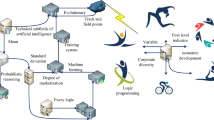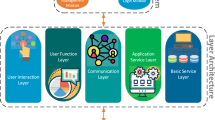Abstract
Self-organization theory has become a hotspot in system engineering scientific theoretical research. However, there are few studies on autonomous adaptation to sports training from the perspective of self-organization theory, and the application of self-organizing neural network models in sports training is relatively rare. Guided by multidisciplinary knowledge and various scientific principles, this article uses modern scientific and technological achievements and adopts scientific training methods and means to implement optimal control over the entire process of sports training. Moreover, this article uses a self-organization theory that has the characteristics of new things and has been successfully used in other fields and neural network models to study sports training adaptation theory. The evaluation model of athletes' training adaptation status established by a self-organizing competitive neural network designed by self-organization principle also proves the feasibility of applying self-organization theory to sports training adaptation.

















Similar content being viewed by others
References
Glazier PS, Mehdizadeh S (2019) Challenging conventional paradigms in applied sports biomechanics research. Sports Med 49(2):171–176
Mullen T, Highton J, Twist C (2015) The internal and external responses to a forward-specific rugby league simulation protocol performed with and without physical contact. Int J Sports Physiol Perform 10(6):746–753
Appelbaum LG, Erickson G (2018) Sports vision training: a review of the state-of-the-art in digital training techniques. Int Rev Sport Exerc Psychol 11(1):160–189
Ridderinkhof KR, Brass M (2015) How kinesthetic motor imagery works: a predictive-processing theory of visualization in sports and motor expertise. J Physiology-Paris 109(1–3):53–63
Mulligan D, Lohse KR, Hodges NJ (2016) An action-incongruent secondary task modulates prediction accuracy in experienced performers: evidence for motor simulation. Psychol Res 80(4):496–509
Khudolii OM, Ivashchenko OV, Iermakov SS et al (2016) Computer simulation of junior gymnasts’ training process. Sci Gymn J 8(3):215–228
Tivener KA, Gloe DS (2015) The effect of high-fidelity cardiopulmonary resuscitation (CPR) simulation on athletic training student knowledge, confidence, emotions, and experiences. Athl Train Educ J 10(2):103–112
Ivashchenko OV, Kapkan OO (2015) Simulation of process of 14–15 years old girls’ training of light athletic and gymnastic exercises. Pedagog Psychol Med–Biol Probl Phys Train sports 8:32–40
Owen PD, King N (2015) Competitive balance measures in sports leagues: the effects of variation in season length. Econ Inq 53(1):731–744
Yang J (2019) The simulation of table tennis during the course of sports. Carib J Sci 52(4):1561–1564
Bulat M, Can NK, Arslan YZ et al (2019) Musculoskeletal simulation tools for understanding mechanisms of lower-limb sports injuries. Curr Sports Med Rep 18(6):210–216
Lopatiev A, Ivashchenko O, Khudolii O et al (2017) Systemic approach and mathematical modeling in physical education and sports. J Phys Educ Sport (JPES) 17(1):146–155
Bennour N (2015) Teaching practices and student action in physical education classes: perspectives for teacher education. Creat Educ 6(10):934–944
Sghaier D, Elandoulsi S, Mami M et al (2015) Physical education teacher’s training in swimming under the joint didactic action. Creat Educ 6(22):2433–2437
de Souza ÍMM, Silva CLD (2015) Body practices and Brazilian culture: pedagogical contributions to physical education professionals. Proc Soc Behav Sci 174:434–440
Cutforth N, Belansky ES (2015) A community-engaged approach to translating research into practice: a physical education story. Progr Community Health Partnersh Res Educ Action 9(4):571–582
Hwang EuiRyong, Kim TaeYoung (2018) Intensification of the education of public health, hygiene, and martial arts during the Japanese colonial period (1937–1945). J Exerc Rehabil 14(2):160–167
Palomo EJ, López-Rubio E (2016) The growing hierarchical neural gas self-organizing neural network. IEEE Trans Neural Netw Learn Syst 28(9):2000–2009
Fátima S, António M, Rocha NBF et al (2015) Kinematic parameters of throwing performance in patients with schizophrenia using a markerless motion capture system. Somatosens Res 32(2):77–86
Kim MK, Kim TY, Lyou J (2015) Performance improvement of an AHRS for motion capture. J Inst Control 21(12):1167–1172
Zhou ZM, Chen ZW (2015) A survey of motion capture data earning as high dimensional time series. Int J Multimed Ubiquitous Eng 10(9):17–30
Khan MA (2016) Multiresolution coding of motion capture data for real-time multimedia applications. Multimed Tools Appl 76(15):1–16
Puupponen A, Wainio T, Burger B et al (2015) Head movements in finnish sign language on the basis of motion capture data: a study of the form and function of nods, nodding, head thrusts, and head pulls. Sign Lang Linguist 18(1):41–89
Giannetti R, Petrella A, Bach J et al (2017) In vivo bone position measurement using high-frequency ultrasound validated with 3-D optical motion capture systems: a feasibility study. J Med Biol Eng 37(7):1–8
Zhang H, Wang L, Chu S et al (2016) Application of optical motion capture technology in power safety entitative simulation training system. Opt Photonics J 06(8):155–163
Zenke F, Gerstner W, Ganguli S (2017) The temporal paradox of Hebbian learning and homeostatic plasticity. Curr Opin Neurobiol 43:166–176
Author information
Authors and Affiliations
Corresponding author
Ethics declarations
Conflict of interest
The authors declare that they have no competing interests.
Additional information
Publisher's Note
Springer Nature remains neutral with regard to jurisdictional claims in published maps and institutional affiliations.
Rights and permissions
About this article
Cite this article
Liang, H. Evaluation of fitness state of sports training based on self-organizing neural network. Neural Comput & Applic 33, 3953–3965 (2021). https://doi.org/10.1007/s00521-020-05551-w
Received:
Accepted:
Published:
Issue Date:
DOI: https://doi.org/10.1007/s00521-020-05551-w




